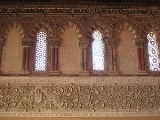
Synagogue of El Transito
Encyclopedia

Toledo, Spain
Toledo's Alcázar became renowned in the 19th and 20th centuries as a military academy. At the outbreak of the Spanish Civil War in 1936 its garrison was famously besieged by Republican forces.-Economy:...
, founded by Samuel ha-Levi in 1336.
Samuel ha-Levi was a diplomat and treasurer at the court of Peter of Castile.
History of changes
After the expulsion of the city's Jews under the Alhambra decreeAlhambra decree
The Alhambra Decree was an edict issued on 31 March 1492 by the joint Catholic Monarchs of Spain ordering the expulsion of Jews from the Kingdom of Spain and its territories and possessions by 31 July of that year.The edict was formally revoked on 16 December 1968, following the Second...
in 1492,
the Synagogue came under the order of Calatrava
Calatrava
-Spain:* Calatrava la Vieja , Spanish medieval town* Calatrava la Nueva, Spanish medieval castle and convent-Philippines:* Calatrava, Negros Occidental, a municipality in the Philippines...
and was transformed into a hospital of the Priorate of Saint Benito.
In the 16th century it became a church of Saint Benito.
Later at the 17th century the name changed into Church of the Nuestra Senora del Transito.
The name derives from the painting: Transit of Virgin.
The synagogue was also used as military headquarters during
the Napoleonic Wars.
In 1877 the building became a national monument.
The transformation of the building into the Sephardi Museum, as it is now officially called,
started around 1910. It was initiated by the Veca-Inclan foundation.
Architecture
This Synagogue was the private family synagogue of the king's wealthy treasurer, Don Samuel ha-Levi AbulafiaAbulafia (disambiguation)
Abulafia is a Sephardi Jewish surname whose etymological origin is in the Arabic language. The family name, like many other Arabic-origin Sephardic Jewish surnames, originated in Spain among Spanish Jews at a time during Spain's Islamic history, when it was ruled as Al-Andalus by Arabic-speaking...
. When he built it around year 1400, he defied all the laws about synagogues being smaller and lower than churches, and plain of decoration. It features Nasrid
Nasrid dynasty
The Nasrid dynasty was the last Moorish and Muslim dynasty in Spain. The Nasrid dynasty rose to power after the defeat of the Almohad Caliphate in 1212 at the Battle of Las Navas de Tolosa...
-style polychrome
Polychrome
Polychrome is one of the terms used to describe the use of multiple colors in one entity. It has also been defined as "The practice of decorating architectural elements, sculpture, etc., in a variety of colors." Polychromatic light is composed of a number of different wavelengths...
stucco
Stucco
Stucco or render is a material made of an aggregate, a binder, and water. Stucco is applied wet and hardens to a very dense solid. It is used as decorative coating for walls and ceilings and as a sculptural and artistic material in architecture...
-work, Hebrew
Hebrew language
Hebrew is a Semitic language of the Afroasiatic language family. Culturally, is it considered by Jews and other religious groups as the language of the Jewish people, though other Jewish languages had originated among diaspora Jews, and the Hebrew language is also used by non-Jewish groups, such...
inscriptions of the names of God, multifoil arch
Arch
An arch is a structure that spans a space and supports a load. Arches appeared as early as the 2nd millennium BC in Mesopotamian brick architecture and their systematic use started with the Ancient Romans who were the first to apply the technique to a wide range of structures.-Technical aspects:The...
es and Mudéjar
Mudéjar
Mudéjar is the name given to individual Moors or Muslims of Al-Andalus who remained in Iberia after the Christian Reconquista but were not converted to Christianity...
panelled ceiling featuring Arabic inscriptions.
Women's Gallery
Women were separated from men during the ceremonies,but were allowed to watch.
The Gallery is located on the first floor of the southern wall,
having five open windows looking down towards Aron Kodesh

